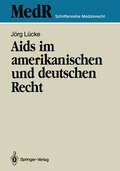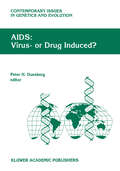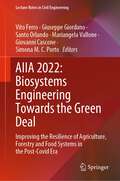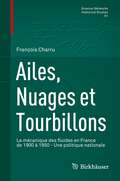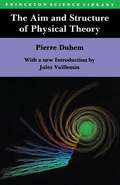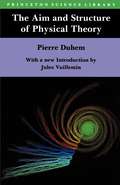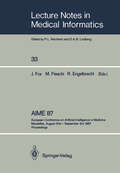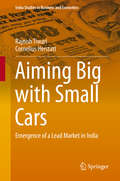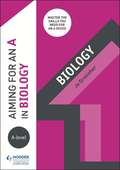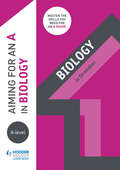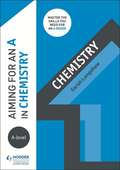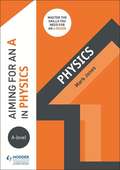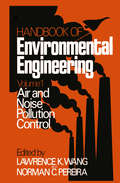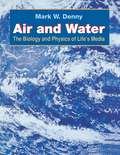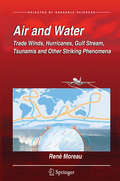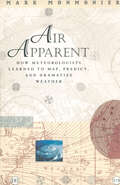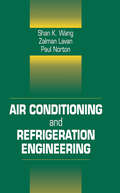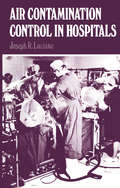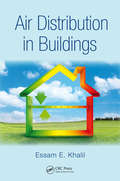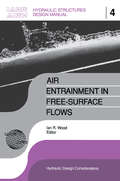- Table View
- List View
Aids im amerikanischen und deutschen Recht: Eine kritische Bestandsaufnahme des Rechts der USA und ihre rechtspolitischen Konsequenzen für die Bundesrepublik Deutschland (MedR Schriftenreihe Medizinrecht)
by Jörg LückeDas Buch stellt - unter Einbeziehung medizinischer Erkenntnisse - ausführlich die in den USA bestehende Rechtslage zur Immunschwächekrankheit Aids dar und vergleicht sie mit dem deutschen Rechtszustand. Behandelt werden - die Aids-Forschungsförderung (Art und Umfang der Förderung) - die Aids-Aufklärung (und zwar der Öffentlichkeit sowie einzelner Gruppen z.B. der Schüler, Lehrer, Ärzte, Gefangenen, Heiratswilligen) - die Pflicht zu HIV-Tests (von Blut- und anderen Spenden sowie von verschiedenen Personengruppen, z.B. der Immigranten, Heiratswilligen, Prostituierten, Gefangenen, Soldaten, Beamten, Krankenhauspatienten und der allgemeinen Bevölkerung) - der Schutz vor einer Diskriminierung HIV-Infizierter (insbesondere im Arbeitsleben, Schulwesen, Wohnungs- und Versicherungswesen). Die amerikanische Rechtslage wird in den einschlägigen Abschnitten jeweils einer umfassenden Bewertung unterzogen und darauf überprüft, ob sie für die Aids betreffende rechtspolitische Diskussion in der Bundesrepublik Deutschland fruchtbar gemacht werden kann.
AIDS: Virus- or Drug Induced? (Contemporary Issues in Genetics and Evolution #5)
by P. H. DuesbergDespite enormous efforts, over 100,000 papers and over $22 billion spent by the US taxpayer alone, the HIV-AIDS hypothesis has failed to produce any public health benefits, no vaccine, no effective drug, no prevention, no cure, not a single life saved. Is the science system to be blamed? Has science failed to reveal the truth about AIDS? In AIDS: Virus or Drug Induced?, two dozen scientists, scholars and journalists have investigated the status quo of AIDS research. Most of them have questioned the HIV-AIDS hypothesis before, but have since been censored, and sociologically excluded from AIDS research, politics and journalism. Here they are united for the first time to put on trial the HIV-AIDS hypothesis. There are those who acquit HIV entirely. Others who make a case for HIV as a necessary, but not a sufficient cause of AIDS. And one medical scientist who, together with the huge AIDS literature, defends the hypothesis that HIV is sufficient to cause AIDS. The book convincingly reveals that the scientific method could very well find a solution to AIDS, but only if ideas can be exchanged freely and if the HIV monopoly can be broken. AIDS: Virus or Drug Induced? illustrates that the solution to AIDS could be as close as one of several, very testable and very affordable alternatives to the unproductive HIV-AIDS hypothesis.
AIIA 2022: Improving the Resilience of Agriculture, Forestry and Food Systems in the Post-Covid Era (Lecture Notes in Civil Engineering #337)
by Vito Ferro Giuseppe Giordano Santo Orlando Mariangela Vallone Giovanni Cascone Simona M. C. PortoThis volume gathers the latest advances, innovations, and applications in the field of biosystems engineering, as presented at the 12th Conference of the Italian Association of Agricultural Engineering (AIIA), held in Palermo, Italy, on September 19-22, 2022. Focusing on the challenges of improving the resilience of agriculture, forestry and food systems in the post-Covid era, it shows how the research has addressed the following topics: Monitoring and modelling hydraulic and hydrological processes in agriculture and forestry systems; Challenges in stream rehabilitation and soil conservation strategies; Sustainable water resource management under climate change scenarios; Planning safe, healthy and resilient territorial, built and green systems; Cultural heritage preservation and rural landscape protection, planning and management; Plant and livestock production processes and technologies. Healthy and Organic farming. Animal welfare; Energy, waste and by-products smart use; Post-harvest logistics and food chain structures technology; Applications and experiences in smart agriculture and forestry; One Health, management and standardization for agriculture and forestry machinery and structures; Big data, machine learning and data hub in biosystems engineering. The contributions were selected by a rigorous peer-review process, and offer an extensive and multidisciplinary overview of the research in the field of biosystems engineering for sustainable agriculture.
Ailes, Nuages et Tourbillons: La mécanique des fluides en France de 1900 à 1950 - Une politique nationale (Science Networks. Historical Studies #61)
by François CharruFrench aeronautics shone brightly in the first decade of the twentieth Century, but declined after the Great War. To remedy this situation, a new Ministry of Air launched in 1929 a large national program of scientific research in fluid mechanics, including the creation of four institutes and five teaching centers in the faculties of sciences in Paris and the provinces. This visionary policy, supported by considerable means, started a quite creative period and led to important achievements notably in the fields of atmospheric turbulence, thermoconvection and wake vortices. The usual picture of a period exclusively dominated by German and British contributions (and growing North-American ones), comes out significantly revised. The fruits of this policy will allow France to play a major role in the creation, after World War II, of the International Union of Theoretical and Applied Mechanics, and are still visible today in the French teaching and research organization. Based on original materials unearthed from a variety of archival sources and scientific papers, the present book recounts this history in all its intertwined scientific, industrial, political and cultural dimensions.Peer-review recommendation: “The text is tremendously well written, and it remains clear and accessible even in its most scientifically advanced dimensions. The author is thus able to address both connoisseurs of the field, who will enjoy reading - and discovering not only scientific but also literary elements and references - and neophytes who are never left by the wayside as the chapters progress. An exceptional and original iconography usefully completes this picture, without overloading it.”L'aéronautique française, qui a tant brillé au début du XXe siècle, décline nettement après la Grande Guerre. Afin de redresser la situation, un nouveau ministère de l'Air lance alors, en 1929, un ambitieux programme en faveur de la recherche en mécanique des fluides, incluant la création de quatre instituts et cinq centres d'enseignement dans les facultés des sciences de Paris et de province. Cette politique visionnaire, dotée de moyens considérables, initie une période très dynamique et créative, en particulier dans les domaines de la turbulence atmosphérique, de la thermoconvection et des tourbillons de sillage. L'image d'un demi-siècle exclusivement dominé par les contributions allemandes et anglaises (et ensuite américaines) s'en trouve notablement transformée. Les fruits de cette politique permettront à la France de jouer un rôle majeur dans la création, après la Seconde Guerre mondiale, de l'Union internationale de mécanique théorique et appliquée, et demeurent visibles aujourd'hui encore dans les structures d'enseignement et de recherche. Fondé sur des documents originaux issus de nombreuses archives et publications, le présent livre raconte cette histoire dans ses différentes dimensions scientifique, industrielle, politique et culturelle.
The Aim and Structure of Physical Theory (Princeton Science Library #126)
by Pierre Maurice DuhemThis classic work in the philosophy of physical science is an incisive and readable account of the scientific method. Pierre Duhem was one of the great figures in French science, a devoted teacher, and a distinguished scholar of the history and philosophy of science. This book represents his most mature thought on a wide range of topics.
The Aim and Structure of Physical Theory
by Pierre Maurice Duhem Philip P. Wiener Jules Vuillemin Louis De BroglieThis classic work in the philosophy of physical science is an incisive and readable account of the scientific method. Pierre Duhem was one of the great figures in French science, a devoted teacher, and a distinguished scholar of the history and philosophy of science. This book represents his most mature thought on a wide range of topics.
AIME 87: European Conference on Artificial Intelligence in Medicine Marseilles, August 31st – September 3rd 1987 Proceedings (Lecture Notes in Medical Informatics #33)
by John FoxThe current scarcity of expert systems where the reasoning is based on Bayesian probability theory may be due to misconceptions about probabilities found in the literature. As argued by Cheeseman (1985), these misconceptions have led to the attitude: "The Bayesian approach doesn't work - so here is a new scheme". Several of these expert systems based on ad hoc "probability" concepts have been successful in a number of ways, demonstrating the necessity of being able to handle uncertainty in medical expert systems. They also demonstrate the need for a theoretically sound handling of uncertainty. In Andersen et al. (1986) it was postulated that knowledge organized in a causal network can be used for a unified approach to the main tasks of a medical expert system: diagnosis, planning of tests and explanations. The present paper explores this postulate in a causal probabilistic network. It also provides a practical demonstration that the problems supposedly associated with probabilistic networks are either non-existent or that practical solutions can be found. This paper reports on the methods implemented in MUNIN* -an expert system for electromyography (EMG) (Andreassen et al. 1987). EMG is the diagnosis of muscle and nerve diseases through analysis of bioelectrical signals from muscle and nerve tissue. In Andreassen et al.
Aiming Big with Small Cars: Emergence of a Lead Market in India (India Studies in Business and Economics)
by Rajnish Tiwari Cornelius HerstattThis book focuses on the small car segment of India's automotive industry to explain the emergence of lead markets. The authors contend that the current understanding of lead markets does not sufficiently explain the business practices that are born out of the intensified globalization of innovation. Lead markets are considered crucial for the global diffusion of new products and this book investigates whether sustainable lead markets can also emerge in developing economies, and if so, under which conditions. The authors question the conventional wisdom and propose updates and extensions to the lead market theory to better reflect the changing ground realities on ground.
Aiming for an A in A-level Biology
by Jo OrmisherExam Board: AQA, CCEA, Edexcel, OCR, WJEC/Eduqas Level: A-level Subject: Biology First teaching: September 2015 First exams: Summer 2017Master the skills you need to set yourself apart and hit the highest grades; this year-round course companion develops the higher-order thinking skills that top-achieving students possess, providing step-by-step guidance, examples and tips for getting an A grade.Written by experienced author and teacher Jo Ormisher, Aiming for an A in A-level Biology:- Helps you develop the 'A grade skills' of analysis, evaluation, creation and application- Takes you step by step through specific skills you need to master in A-level Biology, including scientific reading, quantitative and practical skills , so you can apply these skills and approach each exam question as an A/A* candidate- Clearly shows how to move up the grades with sample responses annotated to highlight the key features of A/A* answers- Helps you practise to achieve the levels expected of top-performing students, using in-class or homework activities and further reading tasks that stretch towards university-level study- Perfects exam technique through practical tips and examples of common pitfalls to avoid - Cultivates effective revision habits for success, with tips and strategies for producing and using revision resources- Supports all exam boards, outlining the Assessment Objectives for reaching the higher levels under the AQA, Edexcel, OCR, WJEC/Eduqas and CCEA specifications
Aiming for an A in A-level Biology (PDF)
by Jo OrmisherMaster the skills you need to set yourself apart and hit the highest grades; this year-round course companion develops the higher-order thinking skills that top-achieving students possess, providing step-by-step guidance, examples and tips for getting an A grade. Written by experienced author and teacher Jo Ormisher, Aiming for an A in A-level Biology: - Helps you develop the 'A grade skills' of analysis, evaluation, creation and application - Takes you step by step through specific skills you need to master in A-level Biology, including scientific reading, quantitative and practical skills , so you can apply these skills and approach each exam question as an A/A* candidate - Clearly shows how to move up the grades with sample responses annotated to highlight the key features of A/A* answers - Helps you practise to achieve the levels expected of top-performing students, using in-class or homework activities and further reading tasks that stretch towards university-level study - Perfects exam technique through practical tips and examples of common pitfalls to avoid - Cultivates effective revision habits for success, with tips and strategies for producing and using revision resources - Supports all exam boards, outlining the Assessment Objectives for reaching the higher levels under the AQA, Edexcel, OCR, WJEC/Eduqas and CCEA specifications
Aiming for an A in A-level Chemistry (PDF)
by Sarah LongshawExam Board: AQA, Edexcel, CCEA, OCR, WJEC Eduqas Level: A-level Subject: Chemistry First teaching: September 2015 First exams: Summer 2017 Master the skills you need to set yourself apart and hit the highest grades; this year-round course companion develops the higher-order thinking skills that top-achieving students possess, providing step-by-step guidance, examples and tips for getting an A grade.Written by experienced author and teacher Sarah Longshaw, Aiming for an A in A-level Chemistry:- Helps you develop the 'A grade skills' of analysis, evaluation, creation and application- Takes you step by step through specific skills you need to master in A-level Chemistry, including scientific reading, quantitative and practical skills, so you can apply these skills and approach each exam question as an A/A* candidate- Clearly shows how to move up the grades with sample responses annotated to highlight the key features of A/A* answers- Helps you practise to achieve the levels expected of top-performing students, using in-class or homework activities and further reading tasks that stretch towards university-level study- Perfects exam technique through practical tips and examples of common pitfalls to avoid - Cultivates effective revision habits for success, with tips and strategies for producing and using revision resources- Supports all exam boards, outlining the Assessment Objectives for reaching the higher levels under the AQA, Edexcel, OCR, WJEC/Eduqas and CCEA specifications.
Aiming for an A in A-level Physics (PDF)
by Mark JonesExam Board: AQA, Edexcel, OCR, WJEC Eduqas Level: A-level Subject: Physics First teaching: September 2015 First exams: Summer 2017Master the skills you need to set yourself apart and hit the highest grades; this year-round course companion develops the higher-order thinking skills that top-achieving students possess, providing step-by-step guidance, examples and tips for getting an A grade.Written by experienced author and teacher Mark Jones, Aiming for an A in A-level Physics:- Helps you develop the 'A grade skills' of analysis, evaluation, creation and application- Takes you step by step through specific skills you need to master in A-level Physics, including scientific reading, quantitative and practical skills, so you can apply these skills and approach each exam question as an A/A* candidate- Clearly shows how to move up the grades with sample responses annotated to highlight the key features of A/A* answers- Helps you practise to achieve the levels expected of top-performing students, using in-class or homework activities and further reading tasks that stretch towards university-level study- Perfects exam technique through practical tips and examples of common pitfalls to avoid - Cultivates effective revision habits for success, with tips and strategies for producing and using revision resources- Supports all exam boards, outlining the Assessment Objectives for reaching the higher levels under the AQA, Edexcel, OCR and WJEC/Eduqas specifications
Air and Noise Pollution Control: Volume 1 (Handbook of Environmental Engineering #1)
by Lawrence K. Wang Norman C. PereiraThe past few years have seen the emergence of a growing, widespread desire in this country, and indeed everywhere, that positive actions be taken to restore the quality of our environment, and to protect it from the degrading effects of all forms of pollution-air, noise, solid waste, and water. Since pollution is a direct or" indirect consequence of waste, if there is no waste, there can be no pollution, and the seemingly idealistic demand for" zero discharge" can be construed as a demand for zero waste. However, as long as there is waste, we can only attempt to abate the consequent pollution by converting it to a less noxious form. In those instances in which a particular type of pollution has been recognized, three major questions usually arise: 1, How serious is the pollution? 2, Is the technology to abate it available? and 3, Do the costs of abatement justify the degree of abatement achieved? The principal intention of this series of books is to help the reader to formulate answers to the last two of the above three questions. The traditional approach of applying tried-and-true solutions to specific pollution problems has been a major factor contributing to the success of environmental engineering, and in large measure has accounted for the establishing of a "methodology of pollution control.
Air and Water: The Biology and Physics of Life's Media
by Mark DennyAddressing general readers and biologists, Mark Denny shows how the physics of fluids (in this case, air and water) influences the often fantastic ways in which life forms adapt themselves to their terrestrial or aquatic "media."
Air and Water: Trade Winds, Hurricanes, Gulf Stream, Tsunamis and Other Striking Phenomena
by René MoreauAir and water are so familiar that we all think we know them. Yet how difficult it remains to predict their behavior, with so many questions butting against the limits of our knowledge. How are cyclones, tornadoes, thunderstorms, tsunamis or floods generated — sometimes causing devastation and death? What will the weather be tomorrow, next week, next summer? This book brings some answers to these questions with a strategy of describing before explaining. Starting by considering air and water in equilibrium (i.e., at rest), it progresses to discuss dynamic phenomena first focusing on large scale structures, such as El Niño or trade winds, then on ever smaller structures, such as low-pressure zones in the atmosphere, clouds, rain, as well as tides and waves. It finishes by describing man-made constructions (dams, ports, power plants, etc.) that serve to domesticate our water resources and put them to work for us. Including over one hundred illustrations and very few equations, most of the text is accessible to readers with no more than high-school science and who are at ease with quantities such as the temperature of a fluid or the pressure within such a medium. Beyond the primary audience of engineers, teachers, and students, the book is thus also addressed to walkers, hikers, navigators, and all nature lovers.
Air Apparent: How Meteorologists Learned to Map, Predict, and Dramatize Weather
by Mark MonmonierWeather maps have made our atmosphere visible, understandable, and at least moderately predictable. In Air Apparent Mark Monmonier traces debates among scientists eager to unravel the enigma of storms and global change, explains strategies for mapping the upper atmosphere and forecasting disaster, and discusses efforts to detect and control air pollution. Fascinating in its scope and detail, Air Apparent makes us take a second look at the weather map, an image that has been, and continues to be, central to our daily lives. "Clever title, rewarding book. Monmonier . . . offers here a basic course in meteorology, which he presents gracefully by means of a history of weather maps." —Scientific American "Mark Monmonier is onto a winner with Air Apparent. . . . It is good, accessible science and excellent history. . . . Read it." —Fred Pearce, New Scientist "[Air Apparent] is a superb first reading for any backyard novice of weather . . . but even the veteran forecaster or researcher will find it engaging and, in some cases, enlightening." —Joe Venuti, Bulletin of the American Meteorological Society "Monmonier is solid enough in his discussion of geographic and meteorological information to satisfy the experienced weather watcher. But even if this information were not presented in such a lively and engaging manner, it would still hook most any reader who checks the weather map every morning or who sits happily entranced through a full cycle of forecasts on the Weather Channel."—Michael Kennedy, Boston Globe
Air breathed in and air breathed out (large print)
by RnibThis page shows a diagram of an experiment about breath, demonstrating the difference between inhaled and exhaled air. There is a locator dot shown, which will be at the top left, when the image is the correct way up. There are two test tubes, one on the left and one on the right of the page. They are both configured the same way with a bung and two tubes. The tube on the left comes out and is bent to the left. The tube on the right comes out and is bent to the right. Both test tubes are half filled with limewater. The lime water on the left is clear and the limewater on the right is cloudy, a pale milky white. In the first test tube the inhaled air would create low pressure in the test tube which would suck air into the test tube from the atmosphere. This air would bubble through the limewater. Atmospheric air contains relatively low levels of carbon dioxide so the limewater stays relatively clear. In the second test tube the exhaled air bubbles through the limewater. Exhaled breath contains much more carbon dioxide so the limewater goes a cloudy, milky white.
Air breathed in and air breathed out (UEB contracted)
by RnibThis page shows a diagram of an experiment about breath, demonstrating the difference between inhaled and exhaled air. There is a locator dot shown, which will be at the top left, when the image is the correct way up. There are two test tubes, one on the left and one on the right of the page. They are both configured the same way with a bung and two tubes. The tube on the left comes out and is bent to the left. The tube on the right comes out and is bent to the right. Both test tubes are half filled with limewater. The lime water on the left is clear and the limewater on the right is cloudy, a pale milky white. In the first test tube the inhaled air would create low pressure in the test tube which would suck air into the test tube from the atmosphere. This air would bubble through the limewater. Atmospheric air contains relatively low levels of carbon dioxide so the limewater stays relatively clear. In the second test tube the exhaled air bubbles through the limewater. Exhaled breath contains much more carbon dioxide so the limewater goes a cloudy, milky white.
Air breathed in and air breathed out (UEB uncontracted)
by RnibThis page shows a diagram of an experiment about breath, demonstrating the difference between inhaled and exhaled air. There is a locator dot shown, which will be at the top left, when the image is the correct way up. There are two test tubes, one on the left and one on the right of the page. They are both configured the same way with a bung and two tubes. The tube on the left comes out and is bent to the left. The tube on the right comes out and is bent to the right. Both test tubes are half filled with limewater. The lime water on the left is clear and the limewater on the right is cloudy, a pale milky white. In the first test tube the inhaled air would create low pressure in the test tube which would suck air into the test tube from the atmosphere. This air would bubble through the limewater. Atmospheric air contains relatively low levels of carbon dioxide so the limewater stays relatively clear. In the second test tube the exhaled air bubbles through the limewater. Exhaled breath contains much more carbon dioxide so the limewater goes a cloudy, milky white.
Air Conditioning and Refrigeration Engineering
by Frank Kreith Shan K. Wang Paul NortonAn air conditioning system consists of components and equipment arranged in sequential order to control and maintain an indoor environment. The goal is to provide a healthy and comfortable climate with acceptable air quality while being energy efficient and cost effective. Air Conditioning and Refrigeration Engineering covers all types of systems from institutional and commercial to residential.The book supplies the basics of design, from selecting the optimum system and equipment to preparing the drawings and specifications. It discusses the four phases of preparing a project: gathering information, developing alternatives, evaluating alternatives, and selling the best solution. In addition, the author breaks down the responsibilities of the engineer, design documents, computer aided design, and government codes and standards.Air Conditioning and Refrigeration Engineering provides you with an easy reference to all aspects of the topic. This resource addresses the most current areas of interest, such as computer-aided design and drafting, desiccant air conditioning and energy conservation. It is a thorough and convenient guide to air conditioning and refrigeration engineering.
Air Conditioning and Refrigeration Engineering (Engineering Handbooks)
by Shan K. Wang, Zalman Lavan and Paul NortonAn air conditioning system consists of components and equipment arranged in sequential order to control and maintain an indoor environment. The goal is to provide a healthy and comfortable climate with acceptable air quality while being energy efficient and cost effective. Air Conditioning and Refrigeration Engineering covers all types of systems from institutional and commercial to residential.The book supplies the basics of design, from selecting the optimum system and equipment to preparing the drawings and specifications. It discusses the four phases of preparing a project: gathering information, developing alternatives, evaluating alternatives, and selling the best solution. In addition, the author breaks down the responsibilities of the engineer, design documents, computer aided design, and government codes and standards.Air Conditioning and Refrigeration Engineering provides you with an easy reference to all aspects of the topic. This resource addresses the most current areas of interest, such as computer-aided design and drafting, desiccant air conditioning and energy conservation. It is a thorough and convenient guide to air conditioning and refrigeration engineering.
Air Contamination Control in Hospitals
by J. LucianoThis is a well conceived and executed volume detailing in close to encyclopedic proportions the question of control of air borne contamination in hospital environments. Many different ap plication areas are described and well documented. Alternative solutions are presented in historical perspective with the neces sary scientific background to provide the uninitiated an oppor tunity to learn not only how to solve a particular problem but more critically why one solution is preferable to another. Every clinician concerned for his patients' welfare must consider the quality of the environment within the hospital--for only there is it potentially controllable Airborne dissemination of nosocomial infections are considered generally rare today. This may be the result of improved intrahospital environmental control or better infection control techniques. If one considers airborne contaminatiqn, real or potential, as undesirable within certain areas of a hospital then proper environmental control must be included in the framework of the physical and functional struc ture. Often it is difficult to specify which controls are needed for a specific application. Frequently this is a problem of in adequate knowledge of the application area and not the availability of technology. Too often, in the rush to provide a solution the newest and most sophisticated equipment is chosen, installed, and found to be more than is required for the task. To avoid these types of errors it is necessary to provide a series of alternative solutions for each problem.
Air Distribution in Buildings
by Essam E. KhalilAir Distribution in Buildings is a concise and practical guide to air distribution system design and managing air conditioning systems in buildings. Making use of 40 years of experience in the design of air conditioning and ventilations systems, and other electromechanical services, this structured reference for built environment engineering offers
Air Entrainment in Free-surface Flow: IAHR Hydraulic Structures Design Manuals 4
by I. R. WoodThis monograph is aimed at the practising hydraulic engineer. Work on it commenced at Professor Naudascher's instigation in 1982. Over the next six years all or some of the authors discussed progress at IAHR sponsored conferences at Esslingen, Melbourne, Lausanne and Beijing. With the authors scattered throughout the world, and all with other responsibilities, progress was bound to be slow. Completion was further delayed by the great increase in published technical literature in this area over the period 1982-1988. This literature continues to expand and with it our understanding of the air water flow phenomena. The monograph must therefore be seen as the authors' views on the state of the art around 1988. More recent references have been included for completeness.This monograph has been a joint effort with most authors making suggestions and contributions to more than one chapter. Nevertheless, the chapter authors are primarily responsible for the material in their chapters.Throughout the monograph symbols are defined when they are fist introduced and a list of symbols is included at the end of each chapter.Many other people have contributed to this monograph, but the authors would particularly like to acknowledge the assistance given by Professor John McNown who has read, commented on and improved the style of the complete monograph.
Air Entrainment in Free-surface Flow: IAHR Hydraulic Structures Design Manuals 4
by Ian R. WoodThis monograph is aimed at the practising hydraulic engineer. Work on it commenced at Professor Naudascher's instigation in 1982. Over the next six years all or some of the authors discussed progress at IAHR sponsored conferences at Esslingen, Melbourne, Lausanne and Beijing. With the authors scattered throughout the world, and all with other responsibilities, progress was bound to be slow. Completion was further delayed by the great increase in published technical literature in this area over the period 1982-1988. This literature continues to expand and with it our understanding of the air water flow phenomena. The monograph must therefore be seen as the authors' views on the state of the art around 1988. More recent references have been included for completeness.This monograph has been a joint effort with most authors making suggestions and contributions to more than one chapter. Nevertheless, the chapter authors are primarily responsible for the material in their chapters.Throughout the monograph symbols are defined when they are fist introduced and a list of symbols is included at the end of each chapter.Many other people have contributed to this monograph, but the authors would particularly like to acknowledge the assistance given by Professor John McNown who has read, commented on and improved the style of the complete monograph.
